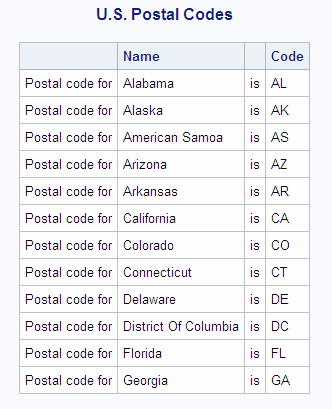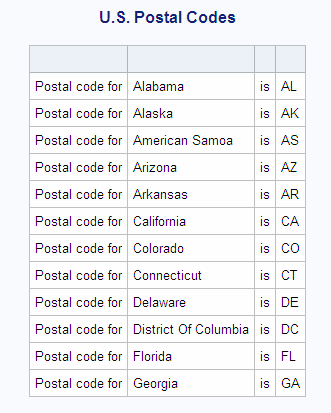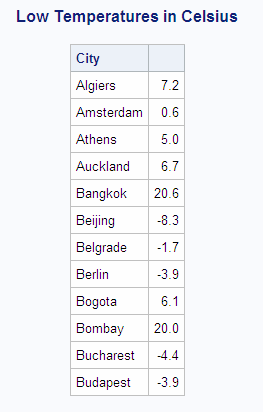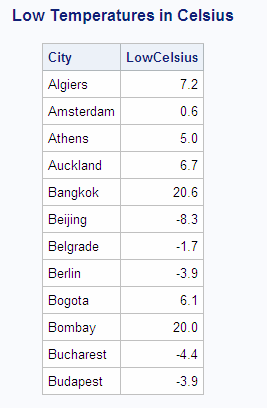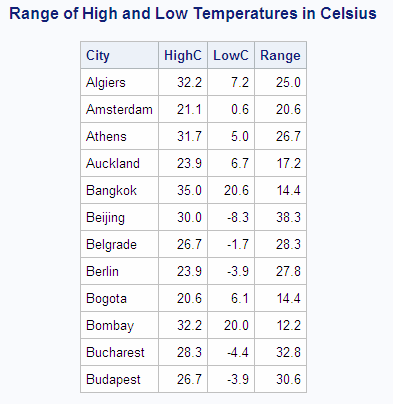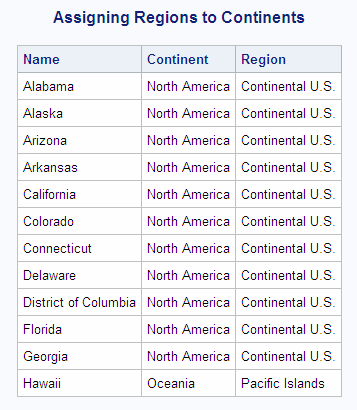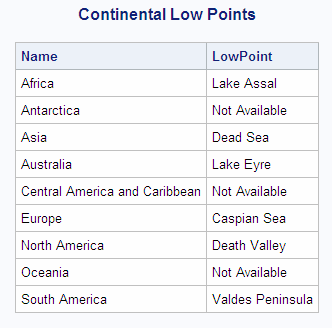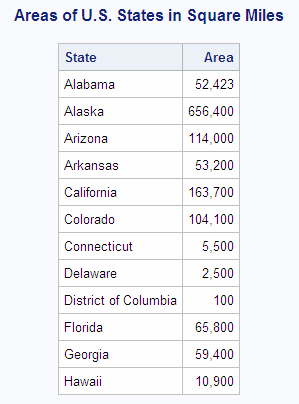Creating New Columns
In addition to selecting columns that are stored in
a table, you can create new columns that exist for the duration of
the query. These columns can contain text or calculations. PROC SQL
writes the columns that you create as if they were columns from the
table.
Adding Text to Output
You can add text to the output by
including a string expression, or literal expression, in a query.
The following query includes two strings as additional columns in
the output:
libname sql 'SAS-library';
proc sql outobs=12;
title 'U.S. Postal Codes';
select 'Postal code for', Name, 'is', Code
from sql.postalcodes; To prevent the column headings Name and Code from printing,
you can assign a label that starts with a special character to each
of the columns. PROC SQL does not output the column name when a label
is assigned, and it does not output labels that begin with special
characters. For example, you could use the following query to suppress
the column headings that PROC SQL displayed in the previous example:
Calculating Values
You can perform calculations with
values that you retrieve from numeric columns. The following example
converts temperatures in the SQL.WORLDTEMPS table from Fahrenheit
to Celsius:
libname sql 'SAS-library';
proc sql outobs=12;
title 'Low Temperatures in Celsius';
select City, (AvgLow - 32) * 5/9 format=4.1
from sql.worldtemps;Note: This example uses the FORMAT
attribute to modify the format of the calculated output. For more
information, see
Specifying Column Attributes.
Assigning a Column Alias
By specifying a column alias, you can assign a new name
to any column within a PROC SQL query. The new name must follow the
rules for SAS names. The name persists only for that query.
When you use an alias
to name a column, you can use the alias to reference the column later
in the query. PROC SQL uses the alias as the column heading in output.
The following example assigns an alias of LowCelsius to the calculated
column from the previous example:
Referring to a Calculated Column by Alias
When you use a column alias to refer to a calculated
value, you must use the CALCULATED keyword with the alias to inform
PROC SQL that the value is calculated within the query. The following
example uses two calculated values, LowC and HighC, to calculate a
third value, Range:
libname sql 'SAS-library';
proc sql outobs=12;
title 'Range of High and Low Temperatures in Celsius';
select City, (AvgHigh - 32) * 5/9 as HighC format=5.1,
(AvgLow - 32) * 5/9 as LowC format=5.1,
(calculated HighC - calculated LowC)
as Range format=4.1
from sql.worldtemps;Note: You can use an alias to refer
to a calculated column in a SELECT clause, a WHERE clause, or ORDER
BY clause.
Note: Because this query sets a
numeric format of 4.1 on the HighC, LowC, and Range columns, the values
in those columns are rounded to the nearest tenth. As a result of
the rounding, some of the values in the HighC and LowC columns do
not reflect the range value output for the Range column. When you
round numeric data values, this type of error sometimes occurs. If
you want to avoid this problem, then you can specify additional decimal
places in the format.
Assigning Values Conditionally
Using a Simple CASE Expression
CASE expressions enable
you to interpret and change some or all of the data values in a column
to make the data more useful or meaningful.
You can use conditional
logic within a query by using a CASE expression to conditionally assign
a value. You can use a CASE expression anywhere that you can use a
column name.
The following table,
which is used in the next example, describes the world climate zones
(rounded to the nearest degree) that exist between Location 1 and
Location 2:
In this example, a CASE
expression determines the climate zone for each city based on the
value in the Latitude column in the SQL.WORLDCITYCOORDS table. The
query also assigns an alias of ClimateZone to the value. You must
close the CASE logic with the END keyword.
libname sql 'SAS-library';
proc sql outobs=12;
title 'Climate Zones of World Cities';
select City, Country, Latitude,
case
when Latitude gt 67 then 'North Frigid'
when 67 ge Latitude ge 23 then 'North Temperate'
when 23 gt Latitude gt -23 then 'Torrid'
when -23 ge Latitude ge -67 then 'South Temperate'
else 'South Frigid'
end as ClimateZone
from sql.worldcitycoords
order by City;Using the CASE-OPERAND Form
You can also construct
a CASE expression by using the CASE-OPERAND form, as in the following
example. This example selects states and assigns them to a region
based on the value of the Continent column:
libname sql 'SAS-library';
proc sql outobs=12;
title 'Assigning Regions to Continents';
select Name, Continent,
case Continent
when 'North America' then 'Continental U.S.'
when 'Oceania' then 'Pacific Islands'
else 'None'
end as Region
from sql.unitedstates;Note: When you use the CASE-OPERAND
form of the CASE expression, the conditions must all be equality tests.
That is, they cannot use comparison operators or other types of operators,
as are used in Using a Simple CASE Expression.
Replacing Missing Values
The
COALESCE function enables you to replace missing values in a column
with a new value that you specify. For every row that the query processes,
the COALESCE function checks each of its arguments until it finds
a nonmissing value, and then returns that value. If all of the arguments
are missing values, then the COALESCE function returns a missing value.
For example, the following query replaces missing values in the LowPoint
column in the SQL.CONTINENTS table with the words
Not
Available:
libname sql 'SAS-library';
proc sql;
title 'Continental Low Points';
select Name, coalesce(LowPoint, 'Not Available') as LowPoint
from sql.continents; Specifying Column Attributes
You can specify the following column attributes, which
determine how SAS data is displayed:
If you do not specify these attributes, then PROC
SQL uses attributes that are already saved in the table or, if no
attributes are saved, then it uses the default attributes.
The following example
assigns a label of
State to the Name
column and a format of COMMA10. to the Area column:
libname sql 'SAS-library';
proc sql outobs=12;
title 'Areas of U.S. States in Square Miles';
select Name label='State', Area format=comma10.
from sql.unitedstates;Copyright © SAS Institute Inc. All rights reserved.
